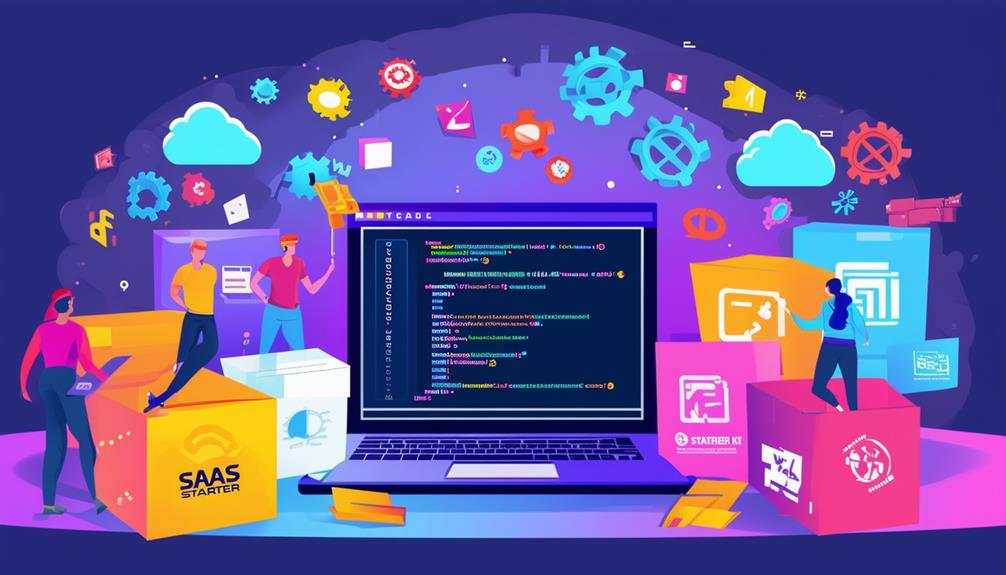You’ve probably wondered what makes SaaS boilerplates tick. They’re powered by a diverse ecosystem of technologies that work together seamlessly. From robust backend frameworks to cutting-edge frontend libraries, these tools form the backbone of modern SaaS applications. But it’s not just about the code; efficient database systems, secure authentication protocols, and scalable cloud services all play significant roles. As you explore the world of SaaS development, you’ll discover how each component contributes to creating powerful, user-friendly applications. Ready to uncover the tech stack that’s revolutionizing the SaaS landscape?
Backend Frameworks and Languages
When building a SaaS boilerplate, you’ll need to choose a robust backend framework and programming language to power your application’s server-side logic. Popular choices include Node.js with Express.js, Ruby on Rails, Django (Python), and Laravel (PHP). These frameworks offer scalability, security features, and extensive libraries to accelerate development.
Node.js is particularly favored for its speed and ability to handle concurrent connections efficiently. It’s used by 85% of Fortune 500 companies, according to the Node.js Foundation. Ruby on Rails, known for its convention over configuration approach, powers platforms like Shopify and Airbnb.
For enterprise-level applications, you might consider .NET Core or Java Spring Boot. These frameworks provide strong performance and integration capabilities with existing systems. Python’s Django is praised for its ‘batteries included’ philosophy, offering built-in admin interfaces and ORM.
When selecting a backend technology, consider factors like your team’s expertise, scalability requirements, and ecosystem support.
Database Management Systems
Choosing the right database management system is essential for your SaaS boilerplate’s performance, scalability, and data integrity. You’ll find that popular SaaS boilerplates often integrate with both SQL and NoSQL databases, offering flexibility for different data structures and use cases.
For relational data, PostgreSQL is a top choice. It’s known for its robustness, ACID compliance, and advanced features like JSON support. MySQL remains popular too, especially for read-heavy applications. If you’re looking for cloud-native options, consider Amazon Aurora or Google Cloud SQL.
On the NoSQL front, MongoDB leads the pack for document-based databases. It’s ideal for handling unstructured data and offers excellent scalability. For high-volume, real-time applications, you might opt for Apache Cassandra or Amazon DynamoDB.
Redis is frequently included in SaaS boilerplates as an in-memory data store, perfect for caching and real-time analytics. Elasticsearch is another common addition, powering fast, full-text search capabilities.
When selecting your database, consider factors like data model complexity, expected traffic, scalability needs, and your team’s expertise. Remember, the right choice can greatly impact your SaaS application’s performance and long-term success.
Frontend Libraries and Frameworks
While database management systems handle the backend, your SaaS boilerplate’s frontend requires robust libraries and frameworks to create engaging, responsive user interfaces.
React, Angular, and Vue.js are the top three frontend frameworks dominating the SaaS landscape. React, developed by Facebook, offers a component-based architecture and virtual DOM for efficient rendering. Angular, maintained by Google, provides a complete MVC framework with powerful two-way data binding. Vue.js, known for its simplicity and flexibility, is gaining popularity among developers.
These frameworks are often complemented by UI component libraries like Material-UI, Bootstrap, or Tailwind CSS. They offer pre-built, customizable components that speed up development and guarantee consistency across your application. For state management, you’ll find Redux, MobX, or Vuex integrated into many SaaS boilerplates.
To enhance user experience, you might incorporate libraries like Chart.js for data visualization, or Moment.js for date and time manipulation.
Progressive Web App (PWA) technologies are also becoming standard in SaaS boilerplates, enabling offline functionality and mobile-like experiences.
Authentication and Authorization Systems
In the domain of SaaS boilerplates, robust authentication and authorization systems are the gatekeepers of your application’s security and user management. These systems guarantee that only authorized users can access specific resources and perform certain actions within your SaaS platform.
Popular authentication methods include JSON Web Tokens (JWT), OAuth 2.0, and OpenID Connect. JWT provides a secure way to transmit information between parties as a JSON object, while OAuth 2.0 is an industry-standard protocol for authorization. OpenID Connect, built on top of OAuth 2.0, adds an identity layer for authentication.
For user management, many SaaS boilerplates integrate solutions like Auth0, Firebase Authentication, or Okta. These services offer features like multi-factor authentication, social login, and user role management out of the box.
When it comes to authorization, Role-Based Access Control (RBAC) is a common approach. It allows you to define user roles and permissions, guaranteeing that users can only access the resources they’re authorized to use.
API Development and Integration
As you build your SaaS boilerplate, API development and integration form the backbone of your application’s functionality and data flow. You’ll need to focus on creating robust, scalable APIs that can handle your SaaS platform’s growing demands. Popular technologies for API development include RESTful architectures, GraphQL, and gRPC.
When designing your APIs, consider using OpenAPI (formerly Swagger) for documentation and standardization. This helps guarantee consistency and ease of use for both internal developers and potential third-party integrators. You’ll want to implement versioning to manage API changes without breaking existing integrations.
For seamless integration, consider using API gateways like Kong or AWS API Gateway. These tools help manage authentication, rate limiting, and traffic routing. Additionally, webhook systems can enable real-time data synchronization between your SaaS and external services.
Don’t forget to implement proper error handling and logging for your APIs. Tools like Sentry or Logstash can help you monitor API performance and troubleshoot issues quickly.
Cloud Services and Hosting
Cloud services and hosting are essential components you’ll need to evaluate when building your SaaS boilerplate, as they provide the infrastructure and scalability necessary for your application’s success. Popular cloud providers like AWS, Google Cloud, and Microsoft Azure offer a wide range of services tailored for SaaS applications.
When choosing a cloud platform, consider factors such as cost, performance, and available features. For instance, AWS’s Elastic Beanstalk and Google’s App Engine provide easy deployment options, while Azure’s Kubernetes Service offers robust container orchestration. According to a 2022 Flexera report, 94% of enterprises use cloud services, with multi-cloud strategies becoming increasingly common.
Don’t overlook the importance of content delivery networks (CDNs) like Cloudflare or Akamai to improve your application’s global performance. These services can reduce latency by up to 50%, enhancing user experience.
For database hosting, managed services like Amazon RDS or Google Cloud SQL can simplify administration tasks. Additionally, serverless options like AWS Lambda or Azure Functions can help you optimize costs by paying only for actual compute time used, potentially reducing expenses by 20-30% compared to traditional hosting models.
DevOps and Deployment Tools
DevOps and deployment tools form the backbone of efficient SaaS development, enabling teams to streamline their workflows and ship updates faster. You’ll find that popular tools like Jenkins, GitLab CI/CD, and CircleCI are vital for automating build, test, and deployment processes. These platforms integrate seamlessly with version control systems, allowing for continuous integration and deployment (CI/CD) pipelines.
For containerization, Docker has become the go-to solution, with 83% of organizations using it in production as of 2020. Kubernetes, the container orchestration platform, is rapidly gaining traction, with 78% of companies adopting it in 2019. These tools guarantee consistency across development, staging, and production environments.
Infrastructure-as-Code (IaC) tools like Terraform and Ansible are essential for managing cloud resources efficiently. They allow you to version-control your infrastructure, reducing configuration errors and improving scalability.
Monitoring and logging tools such as Prometheus, Grafana, and ELK stack (Elasticsearch, Logstash, Kibana) provide real-time insights into your application’s performance and health.
To Wrap Up
You’ve seen how SaaS boilerplates are powered by a diverse tech stack.
From backend frameworks to frontend libraries, these technologies work together to create scalable, efficient solutions.
Don’t forget the essential roles of databases, authentication systems, and API integrations.
Cloud services and DevOps tools are your best friends for hosting and deployment.
By leveraging these technologies, you’ll be well-equipped to build robust SaaS applications that meet modern business needs.






